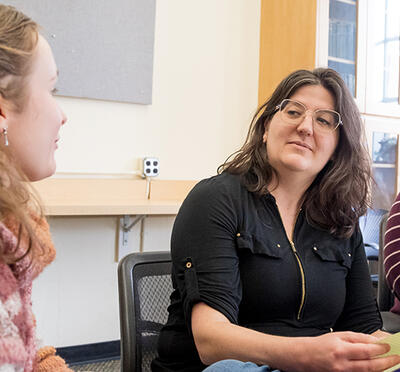Earthquake resilience, RNA sequencing, and ambient light sensors were the topics of the award-winning presentations from the School of Electrical Engineering and Computer Science at the College of Engineering Graduate Research Showcase.
The three graduate student winners earned the honor of presenting their research at the Oregon Stater Awards in Portland, where they were able to network with alumni and industry partners.
The opportunity had a powerful impact for electrical and computer engineering student Vishvas Chalishazar, who has won first place two years in a row for his research on improving electrical grid resilience in the event of an earthquake. He said the experience of presenting last year helped him to explain his work to managers at Portland General Electric (PGE), which led to their current collaboration.
Selfie of Jim Piro and Vishvas Chalishazar Vishvas Chalishazar, whose research is sponsored by Portland General Electric (PGE), had the opportunity to meet with Jim Piro, retired president and CEO of PGE and Oregon State's newest Engineering Hall of Fame member.

There is an urgency for utility companies in the Pacific Northwest to be better prepared for a catastrophic earthquake. Chalishazar is evaluating power systems networks with a novel approach that uses a performance-based earthquake engineering framework that was previously used only for civil structures such as roads, bridges, canals, dams, and buildings.
Chalishazar’s model will be able to simulate several different earthquake scenarios to gather a broad range of data. The ultimate goal of the project is to help PGE find the vulnerable points in its system so the utility can invest in the specific substations that will make the grid more resilient.
“My work has a great impact directly on where the utilities should invest their money so that they can be better prepared for when an earthquake hits,” Chalishazar said. “So this level of responsibility drives me and gets me super excited to do my research and give more than 100 percent towards it.”
Having an impact is also what fuels Dezhong Deng, who was the second-place winner. Deng’s research in computer science impacts biological sciences by improving the predictions of the folding structures of RNA sequences. Current approaches are too slow for long RNAs. The algorithm he developed is the first linear-time algorithm for RNA secondary structure prediction.
“Surprisingly, our algorithm not only runs much faster but also leads to higher overall accuracy on a diverse set of RNA sequences with known structures,” Deng said.
The prediction of RNA secondary structures reveals crucial information about their functions, which can have an impact on the development of new medications.
“I clearly see how my designed algorithms make the RNA folding predictions better, and this really boosts my confidence,” Deng said.
Deng had never been to an alumni awards event, and he appreciated the opportunity to talk to many current and former Oregon Stater award winners. Shaan Sengupta, the third-place winner, said that in addition to alumni he was able to network with people beyond Oregon State, such as researchers from Oregon Health and Science University. And the two events gave him the opportunity to share ideas with professors and graduate students outside his area of electrical and computer engineering, potentially leading to collaborative research efforts.
Sengupta’s research on sensing systems for biological, environmental, and high-energy physics applications involves cross-disciplinary understanding. The research he presented advances technology for ambient light sensors which are used for many applications such as mobile devices, automobiles, buildings, street lighting, and digital signage.
“What excited me the most about the project was piecing together seemingly unconnected existing techniques to come up with a simple, yet effective solution for lower-cost ambient light sensing,” Sengupta said.
His innovative design is completely digital which is different from existing devices that use analog and mixed-signal circuits. The device takes advantage of highly sensitive single-photon avalanche diodes (SPADs) that excel in extremely low-light conditions but saturate in bright lighting. To boost the dynamic range of the SPAD to make it useful in ambient light he combined it with standard CMOS structures to create an optical filter on top of the SPAD.
The event was not only a good experience for the students to interact with a broader audience and perfect their presentation skills but it was also an opportunity for the College of Engineering to showcase its growing graduate program.
“I was personally overwhelmed by the sheer number of high-quality and socially important research results presented by our students,” said Alan Fern, associate head of research for the School of Electrical Engineering and Computer Science. “We are grateful to all of these student for their continued hard work and ingenuity which has transformed us into a world-class research program.”



